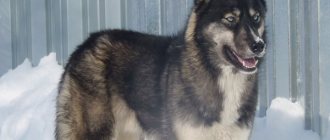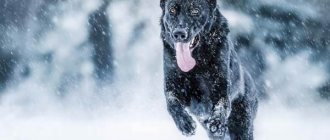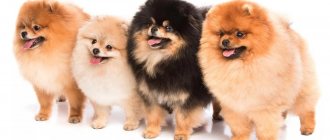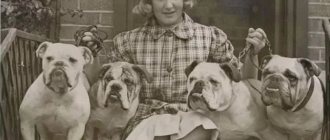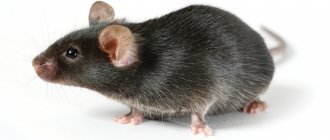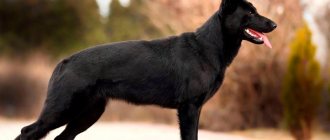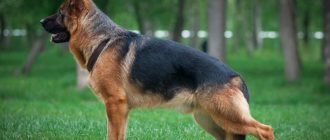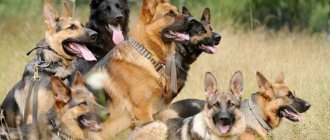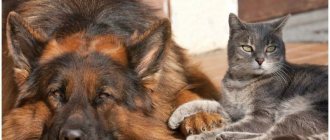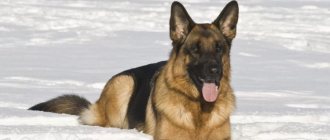It is common to see a German Shepherd in only one color – with a black V-shaped “mantle” on the back and a red underpart. But in fact, they have 3 types of suits with different variations, provided for by the standard.
In addition, there are several more colors. They are considered a marriage. But if you want an unusual dog as a pet, and not for participation in exhibitions, then you can buy an extraordinary puppy.
You can find out what colors “Germans” come in and what they look like in the photo from the article.
How do German Shepherds change color?
The color of the German Shepherd changes gradually. Most newborn puppies have dark coats that look about the same. During the molting period, it turns from smooth and soft to hard. If the puppy has a zonal type color, and the appearance of the additional color is pale brown, with age it acquires brightness and becomes red-red. A gray dog in childhood has the shade of a dirty rag. At four months the fur gradually falls out, by seven months the saddle cloth is already clearly outlined, and by one year the coat ends and the color no longer changes. During the molting period, puppies need to be looked after - combed using a comb or furminator.
Pet Personality
Zonal “Germans” are characterized by such traits as a strong nervous system, balanced temperament, innate protective instinct, alertness, courage, activity and determination.
NOTE!
These are loyal and obedient dogs: friendly towards the owner and members of his family, but at the same time distrustful of strangers.
The zone-colored German Shepherd does not show causeless aggression towards strangers or animals. She is very human-oriented, and, as a rule, strictly follows all the orders of the owner.
A zoned shepherd dog must understand when aggression is appropriate and show it only in situations where it is necessary to protect the owners or their property..
Read more about the German Shepherd's personality here.
What color are adult German Shepherds?
According to the standard, the color of the German is black, zoned and black. Some dog experts distinguish black and tan, but this is not an independent type, but only a variation of the main ones.
Currently, dogs are bred in two directions - for participation in exhibitions and for work. In the second case, what is most valued in a pet is not the color, but the service qualities, so when choosing, they focus on them. During working breeding, the colors of the representatives of the breed have a wide range. Acceptable colors for a German Shepherd include:
- ginger;
- blue;
- black and white;
- white;
- black and red;
- red;
- cream and others.
Black color
The color got its name from the saddle cloth, a bedding made of fur, carpet or cloth under a horse’s saddle. This is exactly what the pattern on the body of a German Shepherd looks like. The color of the dog's back, sides, upper tail, and elbows is black. Tan comes in a variety of shades – from red-red to chocolate. Spreads over the stomach, chest, neck and paws. A prerequisite for the black-backed color is a darkened muzzle, a black mask up to the ears. Its absence is considered a defect according to the standard.
Ginger colour
Red Germans look like they have tan marks all over their fur. They do not meet the standard; when bred for exhibitions, puppies are discarded. However, due to their spectacular appearance and rare colors, they are in great demand, so breeders of working dogs choose them and try to get offspring from red parents.
One of the color varieties is zone-red, with light and dark areas of the coat.
White
White coat occurs in German Shepherds with a recessive gene. The coloring is still controversial. It was recognized as standard only in Canada and the USA; for the rest of the world, white individuals are a defect in the breed. They cannot be considered albinos; this is not a mutation or pathology. Light Shepherds are larger than normal dogs, have a coarser coat, and are energetic, strong, and intelligent. When training, you need to be loyal; in relation to strangers, white Germans are calmer than their dark relatives.
Gray (blue)
The rarest and one of the most beautiful shades of German wool. Individuals of gray color are born due to the appearance of an additional gene that can weaken the black pigment of the coat. After some time, the gray color acquires a blue tint, and the pet looks unusual. Although the color is not recognized by dog handlers as standard, the Blue German has excellent search and guard qualities.
Black and gray shepherds are a common option. They are similar to black-backed birds, but instead of red and tan they have gray lightened areas.
Black and white
White and black spots are a deviation from the standard. This fact does not in any way detract from the merits of a service dog, although it looks like a panda. Spotted “harlequins” will not win medals at exhibitions; they will not be allowed to compete. Black and white coloring is elegant and, perhaps, will become a standard in the future, especially since the Sheltie service breed has such spotting.
Black and Tan
It is not often that you see black and tan shepherds. They belong to the saddle color and come in rich, darkened and weakened shades of tan. The color of the coat consists of dots, spots and stripes on a black background. Dark tan German Shepherds have a peculiarity - with each molt they do not darken, but become lighter. If the shade of tan is saturated, the German Shepherd with a black muzzle, body, and tail has only a small shading of brown coloring on the legs.
Black and red
The black and tan German Shepherd belongs to the saddle color. She looks spectacular, which is why these dogs most often become the winners of exhibitions. The black and tan dog has no advantages over black and zonal dogs, but the combination of rich coat colors gives the service dog additional charm. Different shades of red and tan (from light orange to brick) give the dog a unique appearance.
Red
Red fur is considered to be red fur with a rich tint or simply going into a crimson color. Lightening under the tail, on the chest, paws and muzzle is acceptable. The suit was rejected by the standard, despite the fact that it looks great.
Brown (chocolate)
Puppies of this rare color can appear in the litter of parents of a standard species without a genetic failure. Brown has different shades - from beige to the color of dark chocolate. The latter looks especially beautiful, has slight reddish highlights.
Cream
Another non-standard coat color of the German is cream. Its color variations are fawn, milky, yellowish, pink, and gold is especially impressive.
Sable color
The sable color is quite common and is a type of zonal. It is rare in red shepherds; a combination of black, yellow and gray shades is more often observed. The tips of the hairs and awns are black, the undercoat is smoky, and the mane and shoulders are light.
Zonar
The zonal color is called wolfish. For a long time it predominated among German shepherds. The coloring appeared thanks to the ancestor of the breed - a wolf crossed with a European dog. Over time, new colors were introduced that were fashionable and in demand. Zonar coat predominates in working line individuals participating in training competitions. Breeders are still breeding them, since this color can enhance the pigmentation of the offspring's coat and consolidate the effect for a long time.
Many owners of dogs with zonal coloring believe that they are more resilient and more efficient than others.
Spotted
A German has a spotted coat if he is a cross between a shepherd and a mongrel dog. In this case, the marks are arranged randomly and have different shapes and sizes. Their color ranges from white to red.
Coat types
When talking about the colors of a German Shepherd, one cannot fail to mention the types of its coat.
Representatives of the breed are smooth-haired or standard. And they are long-haired. The latter are found among show line dogs. “Long ones” resemble teddy bears. As a rule, they only have problems with their psyche.
Long-haired Shepherds can be overly cowardly or aggressive. The first ones hide their cowardice behind passive defensive reactions of behavior. That is, such a dog can bark threateningly and pretend that he is about to bite. But as soon as you swing at him, the dog tucks its tail and crouches to the ground. This looks especially terrible at a monobreed show, when the animal undergoes a mutated test. In other words, it is bitten off on the sleeve.
The latter have irrepressible aggression. It is very difficult in the city with such a pet. He tries to taste everything that moves. And this should under no circumstances be allowed. If such a dog once feels superior to a person, there is a high probability of losing control over it. The pet may stop obeying its owner.
German eye and skin colors
According to the standard, the German Shepherd's eyes are dark, but not black. This is not the only option. A German with a light coat color may have dark brown eyes, while a black German may have light eyes. There are different combinations, but it is believed that the most successful, giving maximum expressiveness, is a dull muzzle and chocolate eyes. Gray shepherd dogs with blue eyes and white ones with dark eyes look beautiful.
The eye rims of the Germans are of a rich shade, black spots are visible on the tongue, the skin is grayish, and the tan areas are pink. Black individuals have dark skin throughout, including the ears and anus.
Pigmentation of the muzzle
A special dominant gene is responsible for the black mask (muzzle before and around the eyes), which gives the shepherd dog the expressiveness of the breed. A well-pigmented German Shepherd may have a weakened mask, while a lightly colored one, on the contrary, may have a strong mask.
Dark areas of the eyebrows/forehead are linked to the base color at the genetic level: a dog with an expressionless saddle coat often shows a light forehead, while a deep black mantle “attracts” a black forehead. The unmasked Black and Tan Shepherd resembles a Doberman Pinscher - it has a black muzzle, brown throat and liver-shaped lips. A dog with a zonular color has a sable tint to the eyebrows.
Return to content
Which is better German Shepherd - black or black?
Every dog lover answers this question in his own way. Black coloring is more common; a German is immediately recognized by it. The richer the tones of the coat, the stronger the health; a weakened dog signals the degeneration of the line. When a black-backed puppy is born, it is very dark, then it becomes lighter, but the final appearance is formed by the age of three.
Black Shepherds are born and remain coal-colored for the rest of their lives. They are incredibly popular due to their rich anthracite color, harmonious overall appearance and high performance.
Characteristic diseases
The immunity of the German Shepherd Dog is quite strong. Representatives of the breed rarely get sick. However, not a single dog is immune from the occurrence of various diseases. Common diseases common to Germans include:
- hip dysplasia;
- skin diseases such as eczema or dermatitis;
- otitis – inflammation in the ear;
- Gastric volvulus is a very dangerous condition that, without timely surgical treatment, leads to death (in 100% of cases);
- allergies, including food allergies.
In addition, Germans are susceptible to infectious diseases. Therefore, at 2 months the puppy already receives its first vaccinations. We must not forget about post-vaccination quarantine. Your pet should not be taken outside for two weeks after vaccination.
Photo gallery
To make the right choice in favor of one color or another, first study the possible options and evaluate for what tasks the dog is needed. If the goal is to visit exhibitions, then choose from standard colors, and if such events are not a priority for the owners, then there are other options that are in no way inferior. You can compare the types if you look at the proposed photos.
Recommendations
In conclusion, let's look at a few general recommendations:
- It is not recommended to buy an adult dog for your apartment if you already have other animals (for example, cats or other dogs). There is always a risk that the animals will not make friends, which will turn your life into a nightmare. Therefore, check with the seller in advance whether it is possible to return the dog if it does not make friends with other animals.
- It is recommended to consult a veterinarian regarding food, since there are many expensive but low-quality foods on the market today. If you eat poor food, the risk of developing gastrointestinal diseases and allergies significantly increases, so it’s not worth the risk.
In conclusion, many people take two puppies at once so that the dogs do not get bored. This approach is correct, but keep in mind that two shepherd dogs will play and run around the house a lot, which can lead to damage to furniture, appliances and flooring. Therefore, it is recommended to take very calm puppies so that your home can survive. If you live in a house, then this problem is not critical - after all, puppies can be kept outside during the warm season.
